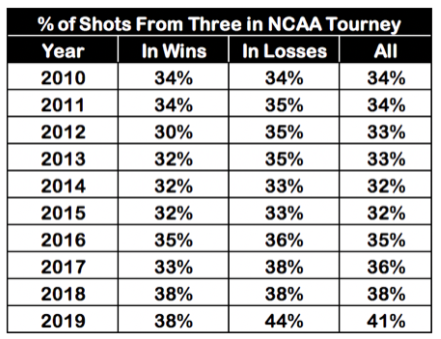Several weeks ago, we posed a provocative proposition – a jump shot is better than a layup – and set out to prove it. In Part 1, we traced the historic evolution of basketball and how coaching philosophy and strategy differed from one region to the next, but finally collided in the 1930s and 40s when Stanford’s Hank Luisetti and Wyoming’s Kenny Sailors dazzled the country with their one-handed jump shooting. In Part 2, we explored the nature of jump shooting and its dramatic impact on basketball. Now, in this final post on the subject, we’ll offer three proofs for our proposition.
Continue reading…Tag Archives: three pointer
A jump shot is better than a layup, Part 2
In Part 1 we traced basketball’s early history culminating in Hank Luisetti and Kenny Sailors’ historic appearances in New York’s Madison Square Garden where they challenged the orthodoxy of the day by shooting one-handed while airborne. In Part II, we’ll explore the evolution of shooting styles in greater detail and show how the modern jump shot transformed basketball in four key ways.
Continue reading…It’s All Relative
In the run-up to this season’s Final Four we were greeted by two interesting but unsurprising commentaries. Unsurprising because they merely confirmed what we already knew: that the number of 3-point attempts in college basketball continues to surge, and correspondingly, the number of dunks has followed suit.
In his April 8th Sports Illustrated piece, citing data compiled by Ken Pomeroy, Andy Staples recounted the record number of treys attempted in the tournament. Back in 2014 and ‘15 the percent of three-point field goal attempts per tournament game hovered around 32% but rose to 35% in 2016, then cleared 38% last season. Through the first 64 games of this year’s tournament, Pomeroy found that the average percent of three-point attempts had grown to nearly 41%.
Hoop Vision’s Jordan Sperber chimed in with a nifty chart, illustrating the trend over a ten-year period.

And what does the dramatic uptick in three-point attempts have to do with the increasing number of dunks generated in this year’s tourney?
Josh Plano’s March 28, 2019 piece at FiveThirtyEight.com revealed that six of this year’s Sweet 16 entries had a dunk share, or percent of 2-point attempts, exceeding 10%. Four years ago, only one did. “This is less about a few dunk-crazed teams and more a reflection of the nationwide trend in college basketball,” reported Plano. On the eve of the Final Four, the season had produced 19,550 dunks, about 2,000 more than just five years ago.
And the reasons?
“We’re seeing more dunks,” ESPN analyst Jay Bilas told The New York Times, “because there are more spectacular athletes out there.” More significantly, though, Bilas cited the symbiotic relationship between 3-pointers and dunks.
The rise of the three as a strategic weapon has created an either-or game: you shoot the three or drive to the rim for a high percentage layup or dunk. You avoid all other lower percentage 2-point attempts. Throw in the long-range accuracy of a Carson Edwards or Kyle Guy and the crazy athleticism of players like Zion Williamson and Ja Morant, and you end up with lots of threes and dunks.
Again, interesting but not really surprising.
While the three-pointer has greatly influenced offensive schemes and strategy, I sometimes wonder if the media echo chamber has overly dramatized its importance, imbuing it with near magical qualities when its actual benefits are, in many ways, quite relative.
Continue reading…… Consequences
In my last post we explored the law of unintended consequences – that strange phenomenon that often occurs when we take an established routine or “way of doing things” – cutting the grass, driving to work, drafting a memo, playing a game, virtually anything – and change the routine or rules or circumstances under which the activity takes place.
Sometimes the change produces the outcome we desire; in other instances, the opposite occurs, often because the participants shift their behavior in unexpected ways in response to the initial change in routine. The well-intended result in one area often ripples into an unintended consequence in another.
I promised to explore how the law of unintended consequences has played out in the world of college basketball. Here goes.
Continue reading…Time Machine
Let’s go back.
In fact, let’s go back forty-five years to an era of college basketball retired sports columnist Mike Loprestti fondly remembers.
“There was no shot clock, no three-pointers and no complaints about lack of scoring. Jacksonville put up 109, 104, 106, and 91 points on its way to the 1970 championship game that it lost to UCLA. Who knew that the more they put in rules friendly to the offense, the lower the scores would go?”
That same year I sat on the Notre Dame bench as the Irish student trainer and witnessed first-hand that historic tournament game I referenced in my last post. The one in which Austin Carr set the single-game tournament scoring record, garnering 61 points against Ohio University in the first round of the 1969-70 tournament.
Today, captured on ancient video tape, the game is not only great fun to watch but is of historic interest as it marks the beginning of the end of one era in college basketball and the launching of the one we now experience. In many ways, it foreshadows what the game was to become and how it began to deteriorate even as it grew in popularity driven by 24/7 cable coverage and the explosion of March Madness. Here’s a quick rundown of what the game tape reveals: Continue reading…
